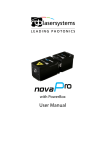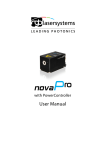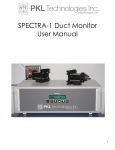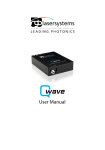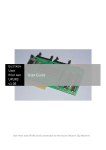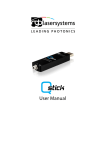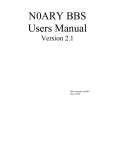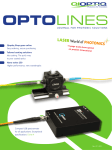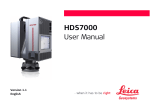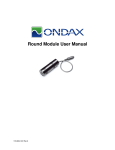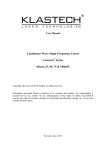Download User Manual
Transcript
User Manual User Manual RGB Lasersysteme GmbH MiniLas Evo Version: 2.0.1 Date: March 27, 2012 This document is protected by copyright. Do not copy or publish this document or parts of it without written permission of RGB Lasersysteme GmbH. Product specifications and descriptions in this manual are subject to change without notice. RGB Lasersysteme GmbH will not be responsible for errors and omissions in this manual or for direct or incidental damages in connection with the use of this device or information. © 2012 RGB Lasersysteme GmbH Donaupark 13 93309 Kelheim Germany Telephone: +49 9441 1750 33 – 0 Website: http://www.rgb-laser.com E-Mail: [email protected] Contents 1 Laser Safety Precautions .............................................................................................. 1 2 Introduction ..................................................................................................................... 2 2.1 2.2 Product Overview ........................................................................................................................... 2 Package Contents ........................................................................................................................... 3 3 Installation and Operation .......................................................................................... 4 3.1 3.2 3.3 Precautions ....................................................................................................................................... 4 Laser operation................................................................................................................................ 4 Troubleshooting ............................................................................................................................. 5 4 Computer Control .......................................................................................................... 7 4.1 4.2 Ltune Laser Control Software ..................................................................................................... 7 Serial Communication .................................................................................................................. 8 5 Specifications ................................................................................................................ 12 5.1 5.2 5.3 5.4 General Specifications ............................................................................................................... 12 Beam Specifications.................................................................................................................... 12 Electrical Specifications ............................................................................................................. 12 Mechanical specifications......................................................................................................... 13 6 Certifications and Compliance ............................................................................... 14 7 Appendix ........................................................................................................................ 17 7.1 List of abbreviations ................................................................................................................... 17 Laser Safety Precautions 1 Laser Safety Precautions CAUTION: This device emits visible and invisible LASER radiation. Avoid exposure to the beam! Lasers emit visible and invisible radiation that may cause damages to material and person, mainly by thermal effect. Radiation entering the human eye can damage the retina, which leads to partial or total loss of vision. The damage can occur without particular perception or sensation of pain. Please consider all protection and safety regulations while handling laser systems. Always use laser protection glasses for the specified wavelength range. Never direct the laser towards people. Keep the laser beam away from reflective surfaces in order to avoid uncontrolled reflections. Do not mount the laser at eye level. It is your responsibility to guarantee the laser safety as required by law. Please pay attention to safety regulations DIN EN 61010-1, DIN EN 60825-1:2003-10 and DIN EN 60950 when operating the laser. The MiniLas series is specified by the United States National Center for Device and Radiological Health (CDRH) as a class 3b laser product. Visible and invisible laser radiation is emitted. Modifications that may affect any aspect of the product’s performance or intended functions will require re-certification and re-identification of the product in accordance with the provisions of 21CFR 1040.10 and 1040.11. MiniLas laser modules are marked with a warning label as show on the right. 1 MiniLas User Manual 2 Introduction 2.1 Product Overview The MiniLas series is currently the world’s smallest complete laser module. In a remarkably small design, it includes not only the laser diode and precision collimating optics, but also the laser controller and power supply via USB. All that is needed for operating and controlling the laser is a simple USB cable connected to a PC. Its compact size makes the MiniLas an ideal choice as a precision light source for space-limited application. The MiniLas Evo emits a free collimated TEM00 laser beam. Also available is the MiniLas Fiber, which couples the laser beam into an optical fiber. Features • • • • • • • • • • 2 Remarkably small design Optical output powers up to 75 mW Powered by USB (no extra power adapter or cable required) Horizontal and vertical mounting options for various rail systems Produced in clean-room atmosphere Temperature monitoring Professional housing USB interface Ltune laser control software included Excellent value for money Introduction 2.2 Package Contents Laser module In order to provide the best beam quality only high quality optical components are used within the laser module. Cable A standard Mini USB cable is used for connecting the laser to a computer or power supply. The length of the cable is 1.5 m (5 ft). Software The CD-ROM includes the Windows application software Ltune for configuring and controlling the laser system as well as this manual as a PDF file. 3 MiniLas User Manual 3 Installation and Operation 3.1 Precautions • Take care of all laser safety instructions as described in chapter 1. Always wear laser protection glasses for the specified wavelength range. • Consider regulations for Electrostatic Discharge (ESD). • Do not open the laser head. Opening the case voids the warranty and may cause uncontrolled laser radiation. • Always mount the laser module securely and pay attention to sufficient heat dissipation. • Do not reflect the laser beam back into the laser head. The laser diode could be damaged if more than 2 % of the emitted power is reflected back into it. Carefully check all mirroring surfaces of your optical setup for possible back reflections. If required, use a suitable optical insulator. • Do not exceed the environment conditions specified in chapter 5. 3.2 Laser operation The MiniLas Evo laser module is controlled via USB and operated in constant CW mode without an external control voltage. 1. 2. 3. 4. 5. 6. 7. In order to set up the laser module for operation, please: Install the Ltune laser control software including the device driver on a Windows PC. Connect the MiniLas laser module to the computer using the supplied USB cable. You can also use any other standard Mini USB cable. After a quick self-test the green POWER LED should be lit continuously. Start the Ltune application on the computer. The laser module should be detected and initialized automatically. Make sure the interlock connector is closed. In Ltune, set the desired output power and click on the power on/off button. The laser will start with a 5 second delay (as required by laser safety regulations). Once the laser is active, the EMISSION indicator is lit. The laser can be switched off remotely from the computer or by simply disconnecting the USB cable. 4 Installation and Operation Status Indicators The laser module includes two LEDs to indicate the laser status: LED Status POWER On Power supply connected, self-test successful Off Power supply not connected Flashing EMISSION Description Error On Laser active, emission possible (depending on selected output power) Off Laser inactive Flashing 5 second delay before activating laser Interlock The interlock connector next to the USB port on the device can be used to enable or disable laser emission. You can either use the supplied jumper to close the contacts or attach a custom switch. If the two pins are not connected, the laser is turned off and no emission is possible. When the two pins are connected again, the laser emissions starts after a 5 second delay, if the laser is remotely turned on and an emission power larger than zero is selected. 3.3 Troubleshooting If the device is detected by Ltune, but there is no laser emission: Please make sure that these conditions are met: • The green LED is lit continuously (if not, please check the bottom of the Ltune window for error messages). • The interlock connector is closed. • The power on/off button in Ltune is turned on • An output power larger than zero is selected. If the device is not detected when Ltune is started: First of all, please disconnect the laser from the computer, restart the computer, connect the laser again and start the Ltune software. If the laser is still not found: The Ltune software communicates with the laser using a "virtual serial port". If the driver is installed correctly, it should show up in the Windows Device Manager. You can open the device manager by clicking Start -> Control Panel (-> Performance and Maintenance) -> System -> Hardware -> Device Manager. 5 MiniLas User Manual In the device manager, please open the "Ports (COM & LPT)" subtree. One of the COM ports listed there should belong to your laser. If you right-click on the correct item, choose "Properties" and then the "Driver" tab page, it should read: "Driver Provider: FTDI" and "Driver Version: 2.8.14.0" (or later). If this is the case, please start Ltune and try to select this COM port manually by unchecking "Auto-scan all serial ports" in "Device setup". If your laser is not listed in the device manager or marked with an exclamation or question mark, please try the following: 1. 2. 3. 4. 5. 6 Disconnect your laser from the computer and from power supply. Download http://www.ftdichip.com/Resources/Utilities/FTClean.zip and run this tool to remove the FTDI driver from your computer. Reinstall Ltune from the CD. Reconnect the laser to the computer. Start Ltune. Computer Control 4 Computer Control The MiniLas uses a USB interface for remote control. The laser can be controlled with • The Windows application software Ltune (included) or • Custom user software via serial communication. 4.1 Ltune Laser Control Software The MiniLas laser can be configured and controlled using the Ltune software for Windows. The software features: • Output power adjustment • Display of the laser status, configuration and operating hours • Temperature display 7 MiniLas User Manual To install the software, simply run the setup file from the CD-ROM included in the package. The setup package then installs the application software and the device driver. For the operating system to properly recognize the device, it’s best if you install the software first before attaching the device. The software is tested with 32 and 64 bit versions of Windows 7, Vista and XP. It requires the Microsoft .NET framework version 3.5, which is already installed on most PCs. If this framework is not installed, the setup package asks you to install it first. You can find the setup file for the .NET framework on the CD or download it from Microsoft’s website. Please note that you need version 3.5 of the framework. Version 4.0 does not include version 3.5. After the software is installed, please connect your Qwave spectrometer to a USB 2.0 port on the computer. You can use the provided USB cable or almost any other Mini-USB cable. The software requires the .net framework 3.5, which is already installed on most PCs and can be downloaded from the Microsoft website, if needed. You can change the user interface to a more compact view by clicking the small button next to “Device properties”. Please also note that the Ltune software works with different laser modules and therefore provides support for some features that are not included in the MiniLas Evo. 4.2 Serial Communication Overview When the laser controller is connected to a PC and the device driver installed, it shows up as a virtual COM port and can be accessed from almost any programming language. A detailed description of the commands and queries is given in the following section. The command settings are not stored when the system is powered down. Communication protocol The commands and queries have the following syntax: Commands: command=<parameter value> A command changes an actual setting. The syntax is the command, followed by an equal sign and the parameter value. The parameter value is the value to be set. Commands have no return value. Queries: query? A query returns information about the device or the value of a setting. The syntax is the query, followed by a question mark. Queries have no parameter value. A query delivers a return value. 8 Computer Control Return Code A return code gives information about the processing of a command or query. There is always a space character between the return code and the result. The return codes are: Code 0 1 2 3 4 5 6 7 8 Name Description COMMAND_SUCCESS Command successful COMMAND_INVALID PARAMETER_ERROR Command invalid Wrong numbers of parameters VALUE_INVALID Parameter value is out of range CODE_INVALID DEVICE_LOCKED Unlocking code is wrong Device is locked for this command FUNCTION_NOT_SUPPORTED This function is not supported COM_TIME_OUT VALUE_NOT_AVAILABLE Timeout while reading command (60 s) This value is currently not available All commands and queries and all responses from the device are followed by the line termination string “\r\n” (carriage return & line feed). All instructions have to be written in capital letters. Initializing the serial communication The MiniLas uses following communication settings: Baud rate 57600 Parity Data bits None 8 Stop bits 1 Turning the laser on and off This command is used to set and read the “Laser Enable” request. The laser can only be activated if the key switch is in the ON position and the interlock is closed. Command/ Query Parameter value Return code Return value O= 0: Delete Enable Request 1: Set Enable Request COMMAND_SUCCESS PARAMETER_ERROR - O? - COMMAND_SUCCESS 0: Enable Request not set 1: Enable Request set 9 MiniLas User Manual Temperature settings The MiniLas Evo monitors the operating temperature. If it exceeds the permitted temperature range, the laser is turned of to prevent damage to the module. Command/ Query Parameter value Return code T? - COMMAND_SUCCESS VALUE_NOT_AVAILABLE LTN? - COMMAND_SUCCESS LTP? - COMMAND_SUCCESS Return value Current temperature in °C Lowest operating temperature in °C Highest operating temperature in °C CW mode The MiniLas laser is operated in CW mode at constant power between 0 and 100 % of the maximum output power. Command/ Parameter value Query P? Output power in mW P= (value between 0 and LP) LP? - Return code Return value COMMAND_SUCCESS COMMAND_SUCCESS VALUE_INVALID Output power in mW COMMAND_SUCCESS Maximum output power in mW - Status and device information The query S? gets the actual status of the laser system including information about the Enable Request, the interlock and active errors. The query R? returns the operation hours of the laser system. The operation time is the accumulated time during which the laser was active (red LED on). Query S? R? DM? DT? DS? DO? DW? DF? DC? 10 - Parameter value Return code COMMAND_SUCCESS Return value Current device status (see table below) - COMMAND_SUCCESS Total operating hours [hhhh:mm] - COMMAND_SUCCESS COMMAND_SUCCESS Manufacturer Device name - COMMAND_SUCCESS Serial number - COMMAND_SUCCESS COMMAND_SUCCESS Software version Emission wavelength in nm - COMMAND_SUCCESS Available features (reserved for future use) - COMMAND_SUCCESS ACC = Active current control APC = Active power control Computer Control The result of the status request S? is a bit-wise combination of the following values: Code 0x01 Mnemonic LASER_ON 0x02 0x04 INTERLOCK_OPEN 0x08 0x10 Description Laser system in active, radiation can be emitted (reserved) ERROR TEMPERATURE_OK The interlock is open Error is active (error can be read with E? query) Temperature of laser head is ok Error status of the laser system The query E? reads the actual active errors of the laser system. Query E? Parameter value - Return code COMMAND_SUCCESS Return value Error code (see table below) Possible error codes: Code 0x01 Mnemonic Description LASER_HEAD_OVERTEMP LASER_HEAD_UNDERTEMP Temperature of laser head is too high Temperature of laser head is too low TEMP_SENSOR_OPEN Temperature-sensor connection is broken 0x40 TEMP_SENSOR_SHORTENED LASER_OVERCURRENT Temperature sensor cable is shortened Current for laser head is too high 0x80 FATAL_INTERNAL_ERROR Internal error (laser system cannot be activated) 0x02 0x04 0x08 11 MiniLas User Manual 5 Specifications 5.1 General Specifications Noise: Power stability: Warm-up time: Drive mode: Control mode: CDRH Classification: Weight: ESD protection: Operating temperature: Storage temperature: < 2 % RMS < 2 % (10 h) 5 sec Active current control (ACC) Constant power, controlled via USB Class 3b 40 g Level 4 0 °C to 45 °C (non-condensing) -25 °C to 70 °C 5.2 Beam Specifications Beam diameter: Divergence: Spatial beam mode: Polarization: Polarization angle: Beam alignment: Pointing stability (10 h): 1.1 × 2.2 to 1.2 × 2.8 mm (depending on wavelength) < 0.9 mrad TEM00 > 100:1 linear vertical < 5 mrad and < 0.1 mm (compared to base mount) < 5 µrad/K 5.3 Electrical Specifications Supply voltage: Supply current: 12 5 V, powered via USB up to 500 mA Specifications 5.4 Mechanical specifications Length: Width: Height: 40.0 mm 25.0 mm 25.0 mm (15.7 “) (9.8 “) (9.8 “) All dimensions in mm. 3D CAD files are available for download on www.rgb-laser.com. 13 MiniLas User Manual 6 Certifications and Compliance CE Declaration of Conformity The manufacturer RGB Lasersysteme GmbH Donaupark 13 93309 Kelheim declares that the following products MiniLas Evo Version 1.0 MiniLas Fiber Version 1.0 comply with the following normative documents EN55022: 2010 EN61000-‐6-‐2: 2005 and therefore with the following EG requirements Electromagnetic compatibility (2004/108/EG) This declaration applies to all models of the above named product versions, in case they will be used in the configuration of the test assembly. Kelheim, 27.03.2012 14 Mathias Reichl Certifications and Compliance FCC Compliance This declaration applies to the following products: MiniLas Evo Version 1.0 MiniLas Fiber Version 1.0 This device complies with part 15 of the FCC Rules. Operation is subject to the following two conditions: (1) This device may not cause harmful interference, and (2) this device must accept any interference received, including interference that may cause undesired operation. This equipment has been tested and found to comply with the limits for a Class A digital device, pursuant to Part 15 of the FCC Rules. These limits are designed to provide reasonable protection against harmful interference when the equipment is operated in a commercial environment. This equipment generates, uses and can radiate radio frequency energy and, if not installed and used in accordance with the instruction manual, may cause harmful interference to radio communications. Operation of this equipment in a residential area is likely to cause harmful interference in which case the user will be required to correct the interference at his own expense. 15 MiniLas User Manual RoHS Declaration of Conformity The manufacturer RGB Lasersysteme GmbH Donaupark 13 93309 Kelheim declares that the following products MiniLas Evo Version 1.0 MiniLas Fiber Version 1.0 contain no toxic substances which are specified in the RoHS Directive 2002/95/EG. The conformity to RoHS Directive 2002/95/EG is confirmed. This declaration applies to all models of the above named product versions. Kelheim, 18.5.2011 16 Mathias Reichl Appendix 7 Appendix 7.1 List of abbreviations °C °F μm μrad AC A BNC CDRH CE CW DC D-SUB9 ESD Hz in K kHz LED m MHz mm mrad nm RMS RoHS sec TEC TEM TTL V VAC VDC W WEEE Degrees centigrade Degrees Fahrenheit Microns Micro radiant Alternating current Ampère BNC connector Center of Device and Radiological Health Conformité Européenne Continuous wave Direct current D-SUB9 connector Electrostatic discharge Hertz inch Kelvin Kilohertz Light emitting diode meters Megahertz Millimeter Milliradiant Nanometer Root mean square Restriction of the use of certain hazardous substances seconds Thermo electric cooler Transverse electromagnetic mode Transistor-transistor logic Volts Volts, alternating current Volts, direct current Watt Waste Electrical and Electronic Equipment 17





















